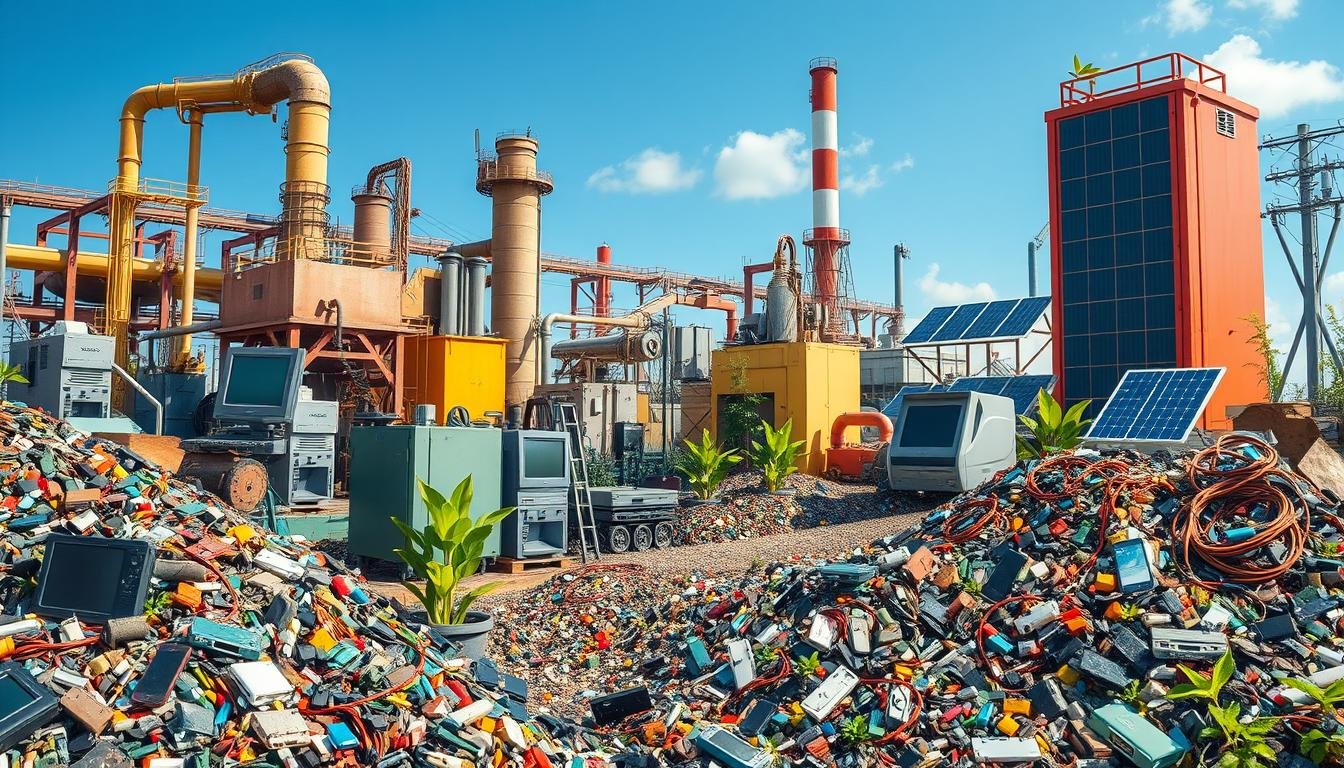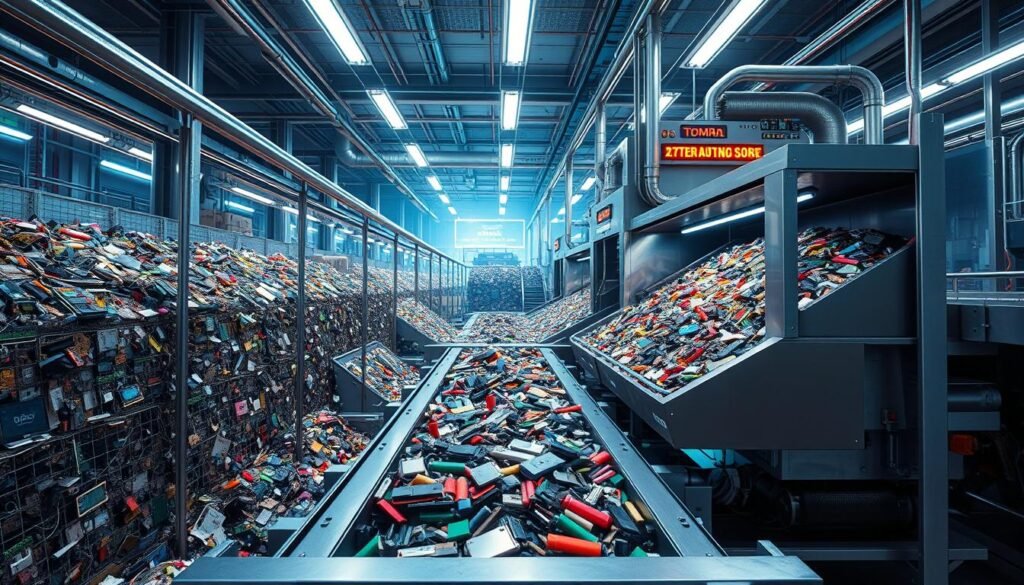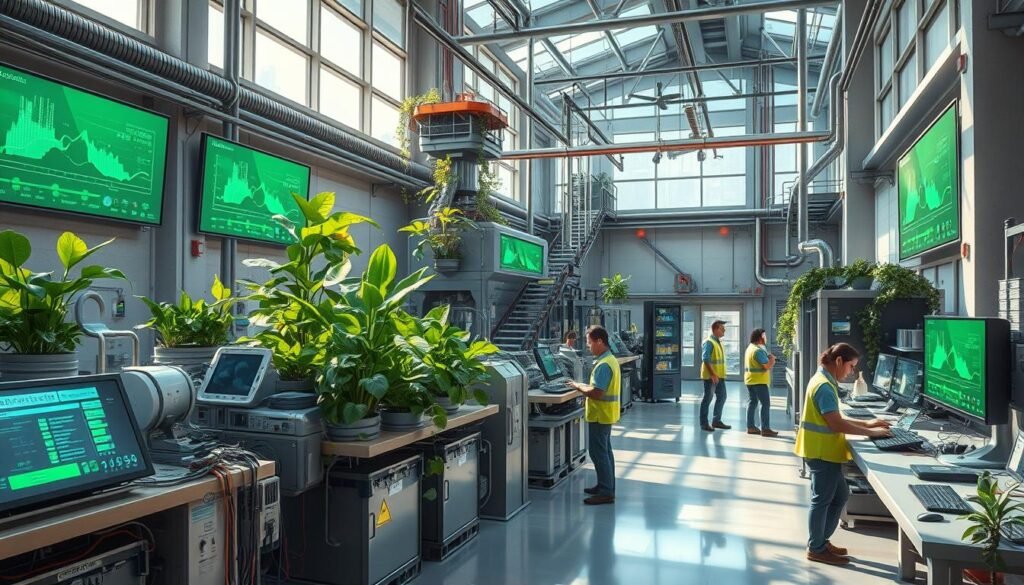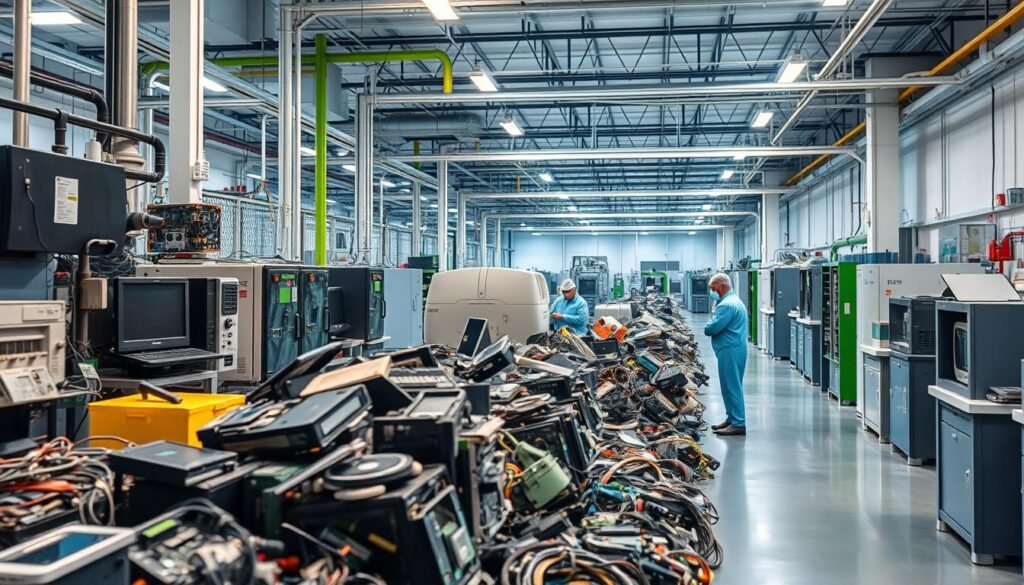Make some changes to the world environment
-
Building 3, Wanyang Innovation City, Langxia Street, Yuyao City, Zhejiang Province

E Waste Recycling Machine: Industrial Solutions Today
Have you ever wondered how industries are tackling the overwhelmingly fast-growing stream of electronic waste (e-waste)? As technology continues to advance, e-waste recycling machines have become indispensable solutions in electronic waste management. Through the use of industrial recycling equipment, we can not only reduce environmental pollution but also recover valuable materials that are often hidden within what we consider discards.
These technological advancements are crucial as the United Nations Environment Programme (UNEP) predicts that e-waste will more than double by 2050, making it the fastest-growing waste stream globally1. By implementing sophisticated machinery such as shredders, granulators, and separators, industries can manage the disposal of old electronics more efficiently and sustainably.
Key Takeaways
- Industries are leveraging advanced e-waste recycling machines to manage electronic waste efficiently.
- E-waste is the fastest-growing waste stream globally and is expected to double by 20501.
- Advanced recycling equipment not only reduces environmental pollution but also recovers valuable materials like copper, gold, and silver1.
- Techniques such as air, gravity, and magnetic separation play crucial roles in effectively sorting different materials2.
- Industrial recycling equipment is pivotal for sustainable advancements in technology and environmental protection.
Introduction to E Waste Recycling
Electronic waste recycling, often termed e-waste recycling, involves the reprocessing and reuse of electronic devices that have outlived their usefulness. In 2022, an estimated 62 million tonnes of e-waste were produced globally, with only 22.3% of it documented as formally collected and recycled3. This startling figure underscores the critical need for efficient recycling systems.
The environmental impact of e-waste is profound, as improper disposal can release toxic substances like lead into the ecosystem, especially through informal activities such as open burning3. Millions of women and child laborers working in the informal e-waste recycling sector are at significant risk of hazardous exposures3. Therefore, proper e-waste recycling is crucial for safeguarding both human health and the environment.
Recycling electronic devices provides numerous benefits, including the recovery of valuable materials like gold, cobalt, and rare earth elements. Despite these advantages, only 17.4% of documented e-waste was recycled in 20194. This gap highlights the imperative of adopting advanced recycling technologies.
The current design of many electronic devices exacerbates the recycling challenge. For instance, smartphones are engineered to be lighter and slimmer, often with non-removable batteries, which makes recycling labor-intensive and complex4. Consequently, only 10 out of 60 chemical elements present in e-waste can be recycled through mechanical processing4.
Efficient e-waste recycling involves several steps, such as manual sorting, de-manufacturing, shredding, metal separation using magnets and Eddy Current, as well as water sorting for non-magnetic materials like plastics and glass4. These processes help mitigate the environmental impact of e-waste while maximizing material recovery.
The rise in e-waste, estimated to reach 53.6 million tons annually, makes it the fastest-growing waste stream globally5. This is compounded by the large volumes of electronic devices like cell phones and computers that end up in US landfills each year5. Consequently, there’s a burgeoning global market for recycled rare earth metals, anticipated to hit $882 million by 20315.
Electronic waste recycling not only recovers critical resources but also supports environmental sustainability and economic growth. By adopting advanced techniques and improving recycling infrastructures, we can leverage the benefits of e-waste recycling to create a more sustainable future.
The Importance of E Waste Recycling Machines
Recycling electronic waste is crucial for preventing environmental contamination and conserving valuable materials. E-waste recycling machines play an integral role in this process by utilizing industrial shredders, electronic granulators, and e-waste separators to efficiently manage the waste.
Shredders
Industrial shredders are essential in breaking down electronic waste into smaller, more manageable particles. This process facilitates easier handling and further processing of the materials. Shredders help to dismantle electronic devices, reducing the risk of hazardous materials like lead, mercury, and cadmium contaminating ecosystems if disposed of improperly6. They also support material recovery by preparing the waste for subsequent sorting and separation stages, ensuring valuable resources are reclaimed and reused.
Granulators
Electronic granulators take the shredded particles and refine them into even smaller sizes. This step enhances the efficiency of the separation process, enabling precise recovery of different materials. Granulators play a significant role in improving the overall performance of e-waste processing equipment, ensuring higher yield rates of recycled materials. By producing smaller, uniform particles, electronic granulators contribute to the effective isolation of valuable metals, further supporting the economic viability of e-waste recycling efforts.
Separators
E-waste separators are pivotal in isolating valuable materials from non-valuable waste. These machines are designed to recover precious metals, such as gold, silver, and platinum, along with other essential materials like copper, aluminum, and rare earth elements7. Properly functioning e-waste separators ensure that these elements are efficiently extracted and diverted from landfills, where they could cause environmental harm. Additionally, by separating recyclable materials, e-waste separators help reduce energy consumption and greenhouse gas emissions associated with producing new electronic devices7.
TOMRA AUTOSORT Fines Optical Sorter
The TOMRA AUTOSORT Fines Optical Sorter stands at the forefront of e-waste recycling technology. This state-of-the-art equipment employs a combination of ultra-high resolution near-infrared spectrometry, camera detection, and high-resolution metal sensors. Integrated with deep laser object detection powered by AI, it ensures accurate sorting and proficient processing of e-waste.

Technology and Innovations
The TOMRA AUTOSORT machine utilizes optical sorting technology to handle the complexities of advanced e-waste sorting. Its FLYING BEAM technology evenly distributes light over the entire belt, allowing for better material recognition and higher recovery rates. According to Premier Surplus, this innovation has enabled them to achieve a 95% material recovery rate on the first pass8. Additionally, the AUTOSORT machine offers a 30-40% better recovery than other sorters, significantly improving efficiency and reducing waste8.
The incorporation of sensor-based sorting technology by TOMRA Recycling Sorting is another significant innovation. It uses up to 320,000 scan points per second for precise data collection, which assists in achieving high rates of recovery and purity with minimal manual sorting required9. This technology is so advanced that it can analyze and sort the equivalent of a soccer stadium covered in trash in less than 15 minutes9.
Functions and Capabilities
The TOMRA AUTOSORT Fines Optical Sorter is versatile, excelling in multiple functions essential for modern e-waste recycling operations. It is designed to recover between 75-90% of materials on the first pass and can selectively sort plastics, lower-grade PCBs, wire, and metals with high purity8. This capability is crucial given the increasing variety of materials found in e-waste, such as various colored circuit boards, which the AUTOSORT Fines technology adeptly sorts.
Furthermore, the TOMRA AUTOSORT machine has considerably expanded e-scrap processing capacities for facilities like Premier Surplus, boosting processing capacity by 300% compared to manual sorting8. With advanced optical sorting technology, the machine ensures an efficient and clean output of materials, which includes metals, circuit boards, and even specific plastic types. The ability to handle such a wide range of materials makes it an invaluable asset for industrial-scale e-waste recycling operations.
| Feature | Advantage |
|---|---|
| FLYING BEAM Technology | Enhanced material recognition |
| Sensor-Based Sorting | High recovery rates with minimal manual intervention |
| Multi-Material Sorting | Handles plastics, PCBs, wires, and metals |
| Advanced AI Integration | Accurate sorting and processing |
Industrial Applications of E Waste Recycling Machines
The industrial applications of e-waste recycling machines play a crucial role in addressing the challenges posed by electronic waste. By integrating advanced recycling technologies, we can significantly enhance material recovery and manage the volume of e-waste effectively.
Material Recovery
E-waste comprises a complex mixture of over 1000 substances, including precious metals such as gold, silver, copper, platinum, and palladium, along with common metals like iron and aluminum10. Incorporating e-waste recycling machines allows us to extract these valuable materials efficiently. Pyrometallurgical and hydrometallurgical industries use methods such as smelting and chemical leaching to recover metals from electronic waste10. For instance, shredders and magnetic separators are used to extract ferrous and non-ferrous metals from e-waste streams11. Smelting furnaces then melt the waste materials to harvest metals like gold, silver, and palladium11. This not only offers economic savings but also benefits the environment by preventing pollution and contamination10.

Volume Management
The e-waste industry continues to witness an increase in the volume of electronic waste generated globally, with an estimated 53.6 million metric tons of e-waste generated in 2019, a figure projected to rise to 74.7 million metric tons by 203012. E-waste recycling machines such as shredders and disassembly machines are essential for reducing the size and managing the volume of this waste effectively11. For instance, shredders are used to recycle larger items such as refrigerators and washing machines by breaking them down into smaller pieces11. Disassembly machines utilize high-temperature heating and detinning methods to break down electronic devices11, facilitating more efficient volume management in recycling operations. This approach contributes to a more sustainable e-waste solution by reducing the spatial footprint of electronic waste and enhancing recycling capabilities.
By leveraging these industrial applications of e-waste recycling machines, we can promote sustainable e-waste solutions and ensure effective management of e-waste materials.
Corporate Sustainability and E Waste Management
Corporate sustainability is becoming increasingly vital in today’s business landscape, particularly regarding corporate e-waste management. Companies across the U.S. are implementing responsible waste disposal and recycling strategies to address the growing problem of electronic waste, which reached over 53.6 million metric tons globally in 2019, with projections indicating it will rise to 74 million tons by 203013.
Many corporations are taking significant steps to integrate sustainable business practices by adopting e-waste recycling machines. These machines not only help in managing the volume of electronic waste but also ensure the recovery of valuable materials, contributing to economic opportunities. In fact, over 2,000 companies are actively involved in e-waste management efforts, reflecting the industry’s focus on technological advancements aimed at recovering rare earth metals and improving recycling efficiency13.
“The e-waste recycling industry is continually evolving, emphasizing a circular economy approach, with corporations designing products for extended life cycles to reduce e-waste generation13.”

Additionally, sustainable business practices in e-waste management are increasingly being adopted to enhance corporate environmental responsibility. By ensuring proper disposal of e-waste, companies can avoid environmental and health risks associated with incorrect handling14. Moreover, programs such as the Box Program, ServiceNow Integration, and TakeBack Envelope Program streamline the return and recycling processes, making it easier for corporations to manage electronic waste efficiently13.
A comprehensive e-waste management strategy involves several key steps. First, conducting an e-waste audit helps corporations assess their volume of outdated electronics and disposal options. Next, choosing certified electronics recyclers ensures data security and proper recycling of materials. Finally, setting clear goals for waste reduction, recycling rates, and data security is crucial for implementing effective corporate sustainability practices15.
Involving employees in the development and implementation of an e-waste recycling program facilitates its success and continuity14. Promoting environmental corporate responsibility through employee engagement and transparent communication of CSR policies can enhance a company’s reputation among stakeholders, investors, and customers15. Establishing a successful e-waste recycling plan involves determining the electronics that can be recycled and ensuring data protection during the recycling process14.
To summarize, corporate sustainability in e-waste management not only helps companies comply with environmental regulations but also fosters a more efficient and sustainable recycling ecosystem. By turning waste into economic opportunities and supporting community-driven environmental initiatives, corporations contribute significantly to a greener future.
Conclusion
The future of e-waste recycling hinges on the continuous advancement and implementation of innovative recycling machines. Such advancements are crucial for ensuring the sustainable management of electronic waste, which is imperative given the millions of tons generated worldwide annually16. These machines play a pivotal role in extracting valuable materials such as gold, silver, and copper from discarded electronics16, thus promoting a circular economy and minimizing the environmental impact of waste disposal.
By investing in state-of-the-art e-waste recycling technology, we not only recover precious resources but also significantly reduce the need for mining, which in turn lowers the carbon footprint of electronic manufacturers16. Additionally, the growth of the e-waste recycling industry in the US alone has created 757,000 jobs, generated $6.7 billion in tax revenues, and accounted for $36.6 billion in wages17. This highlights the profound economic and environmental impact of e-waste recycling.
Ultimately, as we navigate the future of e-waste recycling, our commitment to sustainable electronic waste solutions must remain unwavering. By adopting advanced recycling strategies, we protect our environment, promote economic growth, safeguard natural resources, and ensure a sustainable future for generations to come. The impact of e-waste recycling is far-reaching—benefiting not only our present sustainability efforts but also shaping the environmental landscape of tomorrow.



